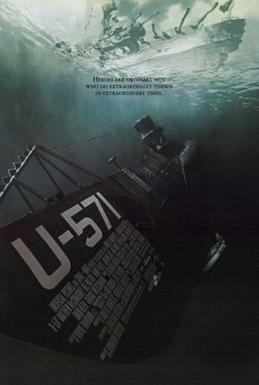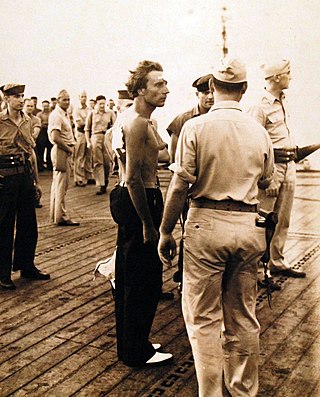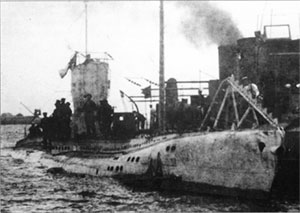
The Kriegsmarine was the navy of Nazi Germany from 1935 to 1945. It superseded the Imperial German Navy of the German Empire (1871–1918) and the inter-war Reichsmarine (1919–1935) of the Weimar Republic. The Kriegsmarine was one of three official branches, along with the Heer and the Luftwaffe, of the Wehrmacht, the German armed forces from 1935 to 1945.

U-571 is a 2000 submarine film directed by Jonathan Mostow from a screenplay he co-wrote with Sam Montgomery and David Ayer. The film stars Matthew McConaughey, Bill Paxton, Harvey Keitel, Jon Bon Jovi, Jake Weber and Matthew Settle. The film follows a World War II German submarine boarded by American submariners to capture her Enigma cipher machine.

U-505 is a German Type IXC submarine built for Germany's Kriegsmarine during World War II. It was captured by the United States Navy on 4 June 1944 and survives as a museum ship in Chicago.

German submarine U-33 was a Type VIIA U-boat of Nazi Germany's Kriegsmarine during World War II.
German submarine U-78 was a Type VIIC submarine of Nazi Germany's Kriegsmarine during World War II. She was the only German submarine to be sunk by land-based artillery fire during the war. Built by Bremen-Vegesack.

German submarine U-96 was a Type VIIC U-boat of the German Navy (Kriegsmarine) during World War II. It was made famous after the war in Lothar-Günther Buchheim's 1973 bestselling novel Das Boot and the 1981 Oscar-nominated film adaptation of the same name, both based on his experience on the submarine as a war correspondent in 1941.

German submarine U-35 was a Type VIIA U-boat of Nazi Germany's Kriegsmarine. She was built three years before the start of World War II. The submarine was laid down on 2 March 1936 by Friedrich Krupp Germaniawerft at Kiel, launched on 24 September 1936, and commissioned on 3 November that year under the command of Kapitänleutnant (Kptlt.) Klaus Ewerth. The U-boat was featured on the cover of Life magazine on 16 October 1939, as in the days preceding, it "courteously" rescued all the sailors of a Greek ship that it was about to sink.
The Befehlshaber der Unterseeboote or BdU was the supreme commander of the German Navy's U-boat Arm (Ubootwaffe) during the First and Second World Wars. The term also referred to the Command HQ of the U-boat arm.

Erich Würdemann was a German submarine commander in World War II and recipient of the Knight's Cross of the Iron Cross of Nazi Germany.

August Maus was a German U-boat commander in World War II and recipient of the Knight's Cross of the Iron Cross of Nazi Germany. Prior to taking command of U-185, he served as an officer on U-68 under the command of Captain Karl-Friedrich Merten. Maus was taken prisoner after the sinking of U-185 and in 1944 participated in an escape attempt from the prisoner-of-war camp Papago Park in the United States.

SM UB-43 was a Type UB II submarine or U-boat for the German Imperial Navy during World War I. UB-43 was sold to the Austro-Hungarian Navy during the war. In Austro-Hungarian service the B was dropped from her name and she was known as SM U-43 or U-XLIII as the lead boat of the Austro-Hungarian U-43 class.
German submarine U-343 was a Type VIIC U-boat of Nazi Germany's Kriegsmarine during World War II. The submarine was laid down on 1 April 1942 at the Nordseewerke yard at Emden, launched on 21 December 1942 and commissioned on 18 February 1943 under the command of Leutnant zur See Wolfgang Rahn.
German submarine U-3505 was a Type XXI submarine of Nazi Germany's Kriegsmarine during World War II. The U-boat was laid down on 9 July 1944 at the Schichau-Werke yard at Danzig, launched on 25 August 1944, and commissioned on 7 October 1944 under the command of Oberleutnant zur See Horst Willner.

SM U-52 was one of 329 submarines serving in the Imperial German Navy in World War I. U-52 was engaged in the naval warfare and took part in the First Battle of the Atlantic.
German submarine U-410 was a Type VIIC U-boat built for Nazi Germany's Kriegsmarine during World War II, operating mainly in the Mediterranean. Her insignia was a sword & shield, she did not suffer any casualties until she was sunk.

German submarine U-105 was a Type IXB U-boat of Nazi Germany's Kriegsmarine. She was ordered on 24 May 1938 as part of Germany's naval rearmament program. Her keel was laid down in Bremen on 16 November 1938. After roughly seven months of construction, she was launched on 15 June 1940 and formally commissioned into the Kriegsmarine on 10 September 1940.
German submarine U-612 was a Type VIIC U-boat built for Nazi Germany's Kriegsmarine for service during World War II. She was ordered on 15 August 1940 and laid down at Blohm & Voss, Hamburg, on 21 April 1941. She was launched on 9 January 1942 and commissioned 5 March 1942 Oberleutnant zur See Paul Siegmann was her first commanding officer. He was joined in May 1942 by Herbert Werner, author of the book Iron Coffins, as First Officer.
Horst Hamm was a German U-boat commander in World War II.
Horst Höltring was a German U-boat commander in World War II.
German submarine U-3034 was a Type XXI U-boat of Nazi Germany's Kriegsmarine, built for service in World War II. She was ordered on 6 November 1943, and was laid down on 14 November 1944 at AG Weser, Bremen as yard number 1193. She was launched on 21 January 1945, and commissioned under the command of Oberleutnant zur See Wilhelm Prehn on 31 March 1945.
This page is based on this
Wikipedia article Text is available under the
CC BY-SA 4.0 license; additional terms may apply.
Images, videos and audio are available under their respective licenses.











